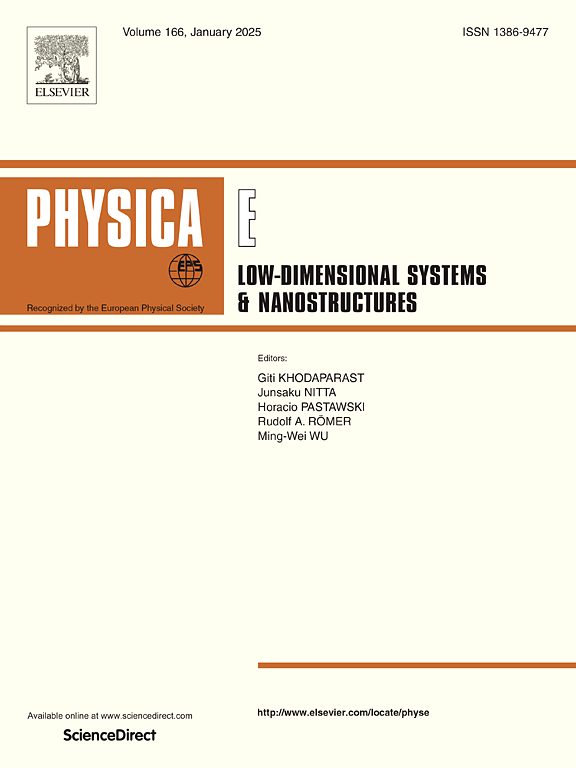Intrinsic spin–orbit interaction in ferromagnet/superconductor hybrid nanostructures: Unveiling the role in triplet generation and critical temperature modulation
IF 2.9
3区 物理与天体物理
Q3 NANOSCIENCE & NANOTECHNOLOGY
Physica E-low-dimensional Systems & Nanostructures
Pub Date : 2025-02-01
DOI:10.1016/j.physe.2024.116162
引用次数: 0
Abstract
Recent theoretical advancements propose an innovative approach to induce triplet generation beyond the conventional inhomogeneous magnetic field-driven singlet–triplet conversion. Here, we investigate a hybrid nanostructure comprising a conventional BCS superconductor proximitized with a homogeneous ferromagnet possessing intrinsic spin–orbit coupling arising from broken symmetries due to lattice mismatch at the interface. Through extensive simulations, we explore the impact of spin–orbit interaction on the critical temperature, revealing the pivotal role played by the in-plane component of the magnetic exchange field and the dimensional characteristics of the hybrid system in singlet–triplet conversion. Remarkably, our findings demonstrate that a single homogeneous ferromagnet with intrinsic spin–orbit coupling governs triplet generation and exhibits a spin valve effect. Notably, we quantify our observations through the superconducting critical temperature (), showcasing a spin-valve like functionality dependent on the orientation of magnetization. Moreover, we observe a significant reduction in the critical temperature of the hybrid structure, even reaching zero under specific dimensions, attributed to the controlled generation and regulation of spin-1 triplets. Crucially, our investigation also validates the notion of the mechanism where a rotation of the in-plane magnetic exchange field toggles superconductivity, offering a promising avenue for actively controlling triplet generation—a pivotal step towards high-performance storage devices in emerging superconducting spintronics applications.
求助全文
约1分钟内获得全文
求助全文
来源期刊
CiteScore
7.30
自引率
6.10%
发文量
356
审稿时长
65 days
期刊介绍:
Physica E: Low-dimensional systems and nanostructures contains papers and invited review articles on the fundamental and applied aspects of physics in low-dimensional electron systems, in semiconductor heterostructures, oxide interfaces, quantum wells and superlattices, quantum wires and dots, novel quantum states of matter such as topological insulators, and Weyl semimetals.
Both theoretical and experimental contributions are invited. Topics suitable for publication in this journal include spin related phenomena, optical and transport properties, many-body effects, integer and fractional quantum Hall effects, quantum spin Hall effect, single electron effects and devices, Majorana fermions, and other novel phenomena.
Keywords:
• topological insulators/superconductors, majorana fermions, Wyel semimetals;
• quantum and neuromorphic computing/quantum information physics and devices based on low dimensional systems;
• layered superconductivity, low dimensional systems with superconducting proximity effect;
• 2D materials such as transition metal dichalcogenides;
• oxide heterostructures including ZnO, SrTiO3 etc;
• carbon nanostructures (graphene, carbon nanotubes, diamond NV center, etc.)
• quantum wells and superlattices;
• quantum Hall effect, quantum spin Hall effect, quantum anomalous Hall effect;
• optical- and phonons-related phenomena;
• magnetic-semiconductor structures;
• charge/spin-, magnon-, skyrmion-, Cooper pair- and majorana fermion- transport and tunneling;
• ultra-fast nonlinear optical phenomena;
• novel devices and applications (such as high performance sensor, solar cell, etc);
• novel growth and fabrication techniques for nanostructures

 求助内容:
求助内容: 应助结果提醒方式:
应助结果提醒方式:


